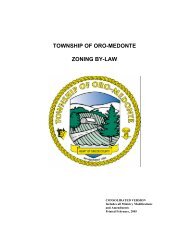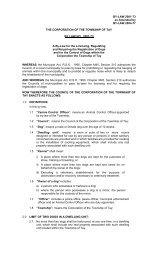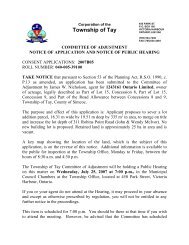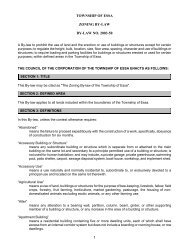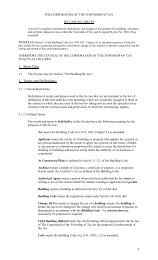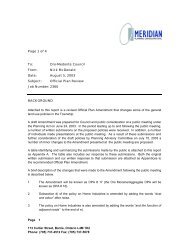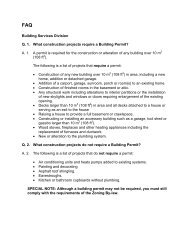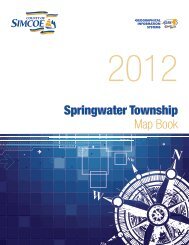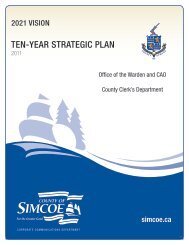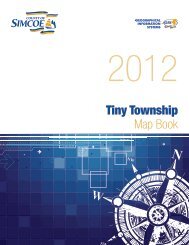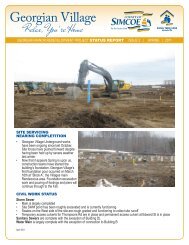Quarterly Report for the Angus Water Treatment Plants and ...
Quarterly Report for the Angus Water Treatment Plants and ...
Quarterly Report for the Angus Water Treatment Plants and ...
Create successful ePaper yourself
Turn your PDF publications into a flip-book with our unique Google optimized e-Paper software.
Introduction:<br />
<strong>Quarterly</strong> <strong>Report</strong> <strong>for</strong> <strong>the</strong> <strong>Angus</strong> <strong>Water</strong> <strong>Treatment</strong> <strong>Plants</strong><br />
<strong>and</strong> Distribution System<br />
Operated by <strong>the</strong> Ontario Clean <strong>Water</strong> Agency (OCWA)<br />
under contract to <strong>the</strong> Township of Essa<br />
<strong>for</strong> <strong>the</strong> period ending September 30th, 2001<br />
This report is a summary of <strong>the</strong> last quarter's water quality, published in accordance with<br />
Ontario’s Drinking <strong>Water</strong> Protection Regulation. It includes important in<strong>for</strong>mation regarding <strong>the</strong><br />
source of your water, analytical test results, <strong>and</strong> how it compares to st<strong>and</strong>ards set by <strong>the</strong> Province.<br />
If you have any questions regarding this report, please contact our Client Services Representative<br />
listed in section 3 below.<br />
During this quarter, <strong>the</strong> Ontario Clean <strong>Water</strong> Agency (OCWA) conducted more than 500 tests <strong>for</strong><br />
water quality parameters. Of tests conducted at an Accredited Laboratory zero samples were<br />
found to exceed <strong>the</strong> Ontario Drinking <strong>Water</strong> St<strong>and</strong>ards as seet out in <strong>the</strong> Ontario Regulation<br />
459/00.<br />
On July 16th, 2001 a low chlorine residual was found leaving <strong>the</strong> plant Mill Street Plant. The<br />
free chlorine residual found in <strong>the</strong> distribution system was less <strong>the</strong> MAC of 0.05 in <strong>the</strong><br />
distribution system. As a result, <strong>the</strong> following remedial actions were taken:<br />
Flushed Mains<br />
Increased <strong>the</strong> chlorine dose<br />
Re-sampled <strong>the</strong> System<br />
During this quarter, 14 turbidity exceedences were reported per Regulation 459/00. Turbidity is<br />
monitored continuosly in-house by online equipment <strong>and</strong> <strong>the</strong> spikes are believed to be caused<br />
from <strong>the</strong> starting <strong>and</strong> stopping of pumps <strong>and</strong>/or air <strong>and</strong> dirt in <strong>the</strong> sample lines.<br />
Compliance With Provincial Regulations:<br />
OCWA operates your water facilities in accordance with provincial regulations. Here is how we<br />
do it:<br />
! Use of Accredited Labs: Analytical tests to monitor your water quality are conducted by a<br />
laboratory audited by <strong>the</strong> Canadian Association <strong>for</strong> Environmental Analytical Laboratories<br />
(CAEAL) <strong>and</strong> accredited by <strong>the</strong> St<strong>and</strong>ards Council of Canada (SCC). Accreditation ensures<br />
that <strong>the</strong> laboratory has acceptable laboratory protocols <strong>and</strong> test methods in place. It also<br />
<strong>Quarterly</strong> <strong>Report</strong> Page 1
<strong>Quarterly</strong> <strong>Report</strong> <strong>for</strong> <strong>Angus</strong> <strong>Water</strong> <strong>Treatment</strong> <strong>Plants</strong> <strong>and</strong> Distribution<br />
System <strong>for</strong> <strong>the</strong> period ending September 30th, 2001<br />
requires <strong>the</strong> laboratory to provide evidence <strong>and</strong> assurances of <strong>the</strong> proficiency of <strong>the</strong> analysts<br />
per<strong>for</strong>ming <strong>the</strong> test methods.<br />
! Operation by Licensed Operators: Your water treatment plant <strong>and</strong> distribution system is<br />
operated <strong>and</strong> maintained by <strong>the</strong> OCWA’s competent <strong>and</strong> licensed staff. The m<strong>and</strong>atory<br />
licensing program <strong>for</strong> operators of drinking water facilities in Ontario is regulated under <strong>the</strong><br />
Ontario <strong>Water</strong> Resources Act (OWRA) Regulation 435/93. Licensing means that an<br />
individual meets <strong>the</strong> education <strong>and</strong> experience requirements <strong>and</strong> has successfully passed <strong>the</strong><br />
certificate exam.<br />
! Sampling <strong>and</strong> Analytical Requirements: OCWA follows a sampling <strong>and</strong> analysis schedule<br />
required by OWRA Regulation 459/00, <strong>the</strong> Ontario drinking <strong>Water</strong> St<strong>and</strong>ards. More<br />
in<strong>for</strong>mation on sampling <strong>and</strong> analysis including results are available in this report <strong>and</strong> from<br />
your municipal office.<br />
! Adherence to Ministry Guidelines <strong>and</strong> Procedures: To ensure <strong>the</strong> protection of <strong>the</strong> public<br />
health <strong>and</strong> operational excellence, <strong>the</strong> OCWA adheres to <strong>the</strong> guidelines <strong>and</strong> procedures<br />
developed by <strong>the</strong> Ministry of Environment <strong>and</strong> <strong>the</strong> Ministry of Health.<br />
System In<strong>for</strong>mation:<br />
Facility Name: <strong>Angus</strong> WT <strong>and</strong> WD<br />
Total Design Capacity Mill St. 3927m 3 /day<br />
McGeorge 2600 m 3 /day<br />
Raw <strong>Water</strong> Source Three drilled wells, 1 at Mill<br />
St. Pump House, 2 at<br />
McGeorge Pump House<br />
Disinfection Method Sodium Hypochlorite<br />
Municipal Location Township of Essa<br />
Service Area<br />
Service Population<br />
Town of <strong>Angus</strong><br />
4218<br />
Client Services: Steve Rohacek<br />
Phone Number (416) 326-4926<br />
E-mail Address<br />
srohacek@OCWA.com<br />
Operations Wayne White<br />
Manager<br />
Phone Number (705)429-2525<br />
E-mail Address<br />
wwhite@OCWA.com<br />
<strong>Quarterly</strong> <strong>Report</strong> Page 2
<strong>Quarterly</strong> <strong>Report</strong> <strong>for</strong> <strong>Angus</strong> <strong>Water</strong> <strong>Treatment</strong> <strong>Plants</strong> <strong>and</strong> Distribution<br />
System <strong>for</strong> <strong>the</strong> period ending September 30th, 2001<br />
Operational Description: Mill St pump house -A single drilled groundwater well can provide<br />
up to 3927 m3/day of a good quality potable water. McGeorge pump house has two drilled<br />
groundwater wells that provide up to 2600 m3/day of potable water. As groundwater is pumped<br />
from <strong>the</strong> well , chemical feed pumps are automatically activated to add sodium silicate (<strong>for</strong> iron<br />
sequestering) <strong>and</strong> sodium hypochlorite (<strong>for</strong> disinfection). Treated water is stored in underground<br />
reservoirs. Flow is measured be<strong>for</strong>e entering <strong>the</strong> reservoir <strong>and</strong> as <strong>the</strong> treated water enters <strong>the</strong><br />
distribution system. It should be noted that <strong>the</strong> Mill Street <strong>Water</strong> treatment plant shares a<br />
distribution system with <strong>the</strong> McGeorge plant. On-line analyzers continuously monitor chlorine<br />
residuals <strong>and</strong> turbidity. St<strong>and</strong>by diesel generators are available as a back-up source in <strong>the</strong> event<br />
of a power failure.<br />
.<br />
Analytical Test Results:<br />
Micro biological<br />
Parameters<br />
July<br />
August<br />
September<br />
Quarter<br />
Summary<br />
MAC / IMAC<br />
Total Coli<strong>for</strong>m<br />
CFU/100mls<br />
Number of Samples<br />
Number of Detectable<br />
Results<br />
Min / Max<br />
Exceedences<br />
40<br />
0<br />
0<br />
0<br />
40<br />
0<br />
0<br />
0<br />
32<br />
0<br />
0<br />
0<br />
112<br />
0<br />
0<br />
0<br />
0<br />
E. Coli<br />
CFU /100mls<br />
Number of Samples<br />
Number of Detectable<br />
Results<br />
Min / Max<br />
Exceedences<br />
40<br />
0<br />
0<br />
0<br />
40<br />
0<br />
0<br />
0<br />
32<br />
0<br />
0<br />
0<br />
112<br />
0<br />
0<br />
0<br />
0<br />
Background<br />
CFU/100 mls<br />
Number of Samples<br />
Number of Detectable<br />
Results<br />
Min / Max<br />
15<br />
1<br />
0/189<br />
16<br />
2<br />
0/92<br />
14<br />
0<br />
0<br />
45<br />
3<br />
0/189<br />
200<br />
<strong>Quarterly</strong> <strong>Report</strong> Page 3
<strong>Quarterly</strong> <strong>Report</strong> <strong>for</strong> <strong>Angus</strong> <strong>Water</strong> <strong>Treatment</strong> <strong>Plants</strong> <strong>and</strong> Distribution<br />
System <strong>for</strong> <strong>the</strong> period ending September 30th, 2001<br />
Exceedences<br />
0<br />
0<br />
0<br />
0<br />
Typical Source of<br />
Contamination<br />
Microbial contaminants, such as viruses <strong>and</strong> bacteria, may come from septic systems,<br />
agricultural livestock operations, wildlife, <strong>and</strong> wastewater treatment plants.<br />
Comments: NONE OF THE MICROBIOLOGICAL TESTS EXCEEDED THE MAC/IMAC LIMITS<br />
DURING THIS QUARTER.<br />
Operational<br />
Parameters<br />
July<br />
August<br />
September<br />
Quarter<br />
Summary<br />
MAC / IMAC<br />
Chlorine Residual<br />
Number of Samples<br />
Number of Detectable<br />
Results<br />
Min / Max<br />
Exceedences<br />
31<br />
31<br />
2<br />
31<br />
0.02/>2<br />
30<br />
0.05/>2<br />
Min / Max<br />
1<br />
Exceedences<br />
8<br />
2<br />
4 13<br />
Comments: Turbidity <strong>and</strong> chlorine are monitored continuously with on-line equipment. Operations staff collect grab<br />
samples during <strong>the</strong>ir plant checks <strong>and</strong> measure <strong>the</strong> chlorine <strong>and</strong> turbidity with pocket instruments as a comparison to<br />
<strong>the</strong> continuous equipment. All turbidity spikes are reported as per reg.459/00.<br />
31<br />
30<br />
92<br />
92<br />
Volatile Organic<br />
Parameters<br />
July<br />
August<br />
September<br />
Quarter<br />
Summary<br />
MAC / IMAC<br />
Typical Source of<br />
Contamination<br />
Organic Chemical Contaminants, including syn<strong>the</strong>tic <strong>and</strong> volatile organic chemicals, that<br />
are byproducts of industrial processes <strong>and</strong> petroleum production, <strong>and</strong> can also come from<br />
gas stations, urban storm water runoff, <strong>and</strong> septic systems.<br />
Comments: VOLATILE ORGANIC PARAMETERS WERE TESTED IN JULY OF THIS QUARTER AND<br />
NO EXCEEDENCES OCCURED.<br />
<strong>Quarterly</strong> <strong>Report</strong> Page 4
<strong>Quarterly</strong> <strong>Report</strong> <strong>for</strong> <strong>Angus</strong> <strong>Water</strong> <strong>Treatment</strong> <strong>Plants</strong> <strong>and</strong> Distribution<br />
System <strong>for</strong> <strong>the</strong> period ending September 30th, 2001<br />
Inorganic Parameters<br />
July<br />
August<br />
September<br />
Quarter<br />
Summary<br />
MAC / IMAC<br />
Typical Source of<br />
Contamination<br />
Inorganic contaminants, such as salts <strong>and</strong> metals, can be naturally-occurring or result from<br />
urban storm water runoff, industrial, or domestic wastewater discharges, oil & gas<br />
production, mining.<br />
Comments: INORGANIC PARAMETERS WERE NOT TESTED IN THIS QUARTER.<br />
Pesticides <strong>and</strong> PCB<br />
Parameters<br />
July<br />
August<br />
September<br />
Quarter<br />
Summary<br />
MAC / IMAC<br />
Typical Source of<br />
Contamination<br />
Pesticides <strong>and</strong> herbicides, may come from a variety of sources such as agriculture,<br />
urban storm water runoff, <strong>and</strong> residential uses.<br />
Comments: PESTICIDES AND PCB PARAMETERS WERE TESTED JULY OF THIS QUARTER AND<br />
NO EXCEEDENCES OCCURED.<br />
Radiological<br />
Parameters<br />
July<br />
August<br />
September<br />
Quarter<br />
Summary<br />
MAC / IMAC<br />
Typical Source of<br />
Contamination<br />
Man made or natural elements emitting radiation in <strong>the</strong> <strong>for</strong>m of alpha, beta or gamma<br />
particles<br />
Comments: RADIOLOGICAL PARAMETERS WERE NOT TESTED IN THIS QUARTER.<br />
Discussion of Analytical Results:<br />
On <strong>the</strong> 16th of July, a low chlorine residual was found leaving <strong>the</strong> plant <strong>and</strong> in <strong>the</strong> distribution<br />
system due to alarm failure. Mains were immediately flushed <strong>and</strong> <strong>the</strong> chlorine dosage was<br />
increased.<br />
<strong>Quarterly</strong> <strong>Report</strong> Page 5
<strong>Quarterly</strong> <strong>Report</strong> <strong>for</strong> <strong>Angus</strong> <strong>Water</strong> <strong>Treatment</strong> <strong>Plants</strong> <strong>and</strong> Distribution<br />
System <strong>for</strong> <strong>the</strong> period ending September 30th, 2001<br />
In this quarter <strong>the</strong>re were many turbidity spikes. These spikes were reported as per Reg. 459/00.<br />
It should be noted that at <strong>the</strong> times of all <strong>the</strong> turbidity spikes that <strong>the</strong> system was receiving<br />
adequate disinfection. Turbidity spikes are an ongoing problem <strong>and</strong> is believed to be<br />
equipment-related. Spikes can occur from pump cycles as well as air <strong>and</strong>/or dirt in <strong>the</strong> sample<br />
lines. The spikes are being reported as per Reg.459/00.<br />
Availability of Analytical Test Results:<br />
The certificate of approval from <strong>the</strong> Ministry of <strong>the</strong> Environment, <strong>and</strong> Regulation 459/00 sets out<br />
monitoring requirements <strong>for</strong> your water. The tables above summarize all <strong>the</strong> results required <strong>for</strong><br />
inclusion in quarterly reports. Your water is extensively tested <strong>for</strong> <strong>the</strong> presence of dozens of<br />
compounds. Some compounds, not listed above, may be present in low concentrations <strong>and</strong> <strong>the</strong>ir<br />
presence does not necessarily mean that <strong>the</strong> water poses a health risk. Results of all analytical<br />
tests are available through your municipal office.<br />
Definitions <strong>and</strong> Abbreviations:<br />
! MAC - Maximum Acceptable Concentration.<br />
! IMAC - Interim Maximum Acceptable Concentration.<br />
! Coli<strong>for</strong>m Bacteria - a group of commonly occurring rod shaped bacteria. Their presence in<br />
a water sample is indicative of inadequate filtration <strong>and</strong>/or disinfection.<br />
! Fecal Coli<strong>for</strong>m Bacteria - refers to a subgroup of coli<strong>for</strong>m bacteria present in <strong>the</strong> digestive<br />
system of warm blooded animals <strong>and</strong> humans.<br />
! Heterotrophic Plate Count - a method of measuring bacterial content in water samples.<br />
Also known as St<strong>and</strong>ard Plate Count.<br />
! Organic Parameter - a group of chemical compounds containing carbon.<br />
! Inorganic Parameter - a group of chemical compounds not containing carbon.<br />
! Raw <strong>Water</strong> - Surface or ground water available as a source of drinking water that has not<br />
received any treatment.<br />
<strong>Quarterly</strong> <strong>Report</strong> Page 6





